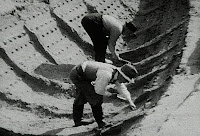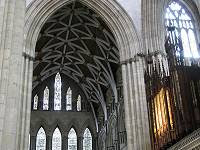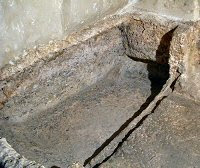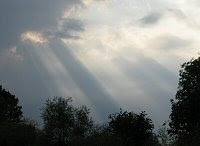This month's Synchroblog invites us to speculate. (Other contributions to this month's Synchroblog are listed at the bottom of this post.)
Here's an extract from the instructions...
Try to imagine that some or all of the Bible narrative is not necessarily true history, but is myth of one sort or another. What sort of effect would that knowledge have on your faith? What effect might it have on the larger church? How would it change you? Would it change you and how you view the world?
Of course, a great deal depends on what part of the Bible I select. Assuming that the visit of the magi to Jesus' birthplace is a myth would make relatively little difference, but assuming that the birth of Jesus is a myth would change things rather dramatically.
I'm going to choose the creation accounts in Genesis. Let's suppose these are myths. How would it change things? I'll follow through with the questions from the Synchroblog. But first, let's have bit of a think about the idea of a myth. What do we mean by 'myth'?
Myths - Perhaps we think of anything mythical or mythological as false. A myth is an invention, imagined creatures in an imagined land - isn't that myth?
Well, no, not necessarily. Imagined creatures in an imagined land are fiction, like 'The Lord of the Rings' or 'The Narnia Chronicles'. Bear in mind that those stories contain a great deal of truth even though they are not true. But myth is more than fiction. To be precise, traditional fiction with a meaning is not a myth but a fable.
We'd do better to think of the Greek legends, the Norse sagas, or the Irish ballads. These are truly mythical. Rather than fiction they are meaningful and explanatory stories based (probably) on real events far back in time before anyone could remember and passed from generation to generation. They have, no doubt, grown considerably in the telling.
So now to the creation accounts in Genesis.
What would be the effect on my faith? - Zero, nada, zilch. There are a number of reasons for this. Perhaps the major one is that I do regard the creation story to be myth. But I'm confident it's myth with a clear purpose. I was trained in biology and for many years worked as a professional biologist. I'm no more inclined to accept the creation stories as history than I am to accept that the Moon is made of cheese.
Let me distinguish between creation and the Biblical accounts of creation. I accept that the Almighty created the universe. It's really hard to think that the universe just is, that it sprang out of nothing all by itself. I am sure that it was somehow caused. It's here because it was intended and spoken into existence.
On the other hand the biblical accounts of how that happened and in what order make little sense to me. What I mean is that they make little sense as history, as an account of the process that took place. As myth, as allegory, as a description of truth, they make perfect sense. The truth is that the Almighty is the ultimate cause of the universe, he is holy, pure and powerful, his original purpose for us is that we would be in community with him, but we are weak, willful and sinful and threw away that opportunity for community.
My opinion that the creation stories are myths doesn't affect my faith in any way. I believe in the Creator, that the universe came into existence because Yahweh spoke, Jesus acted, and the Spirit hovered. The power of the Presence of the three-in-one was enough, a baby universe was born and has flourished ever since. I know that I have a sinful nature, I know that the Son came and by his death paid the price and opened the way for freedom. I know there is a place waiting for me in his kingdom, that my name is written in the Lamb's book of life and on the palm of Papa's hand.
What effect does it have on the wider church? - Now things get more serious. Part of the church thinks it makes little difference whether the creation accounts are factual or mythical. Part of it cares enough to fight a civil war over the issue. And this is a serious problem.
You see, the church that Jesus commanded, 'Love one another as I have loved you', should never, ever be at war with itself. The problem is not that I or anyone else has this or that opinion about the creation stories in Genesis, the problem is that we cannot bear for there to be more than one such opinion.
Some say 'Myth with a message' and others say 'Historical record of real events' and we think that endless argument and dispute is a suitable way to resolve it. Or rather, that our need to be proved 'right' is sometimes stronger than our urge to follow Jesus' command to accept and love.
In a bleeding, dying world we don't have time to fight a civil war. Not only that, we risk bringing the name of Jesus into disrepute. So love one another, love your neighbour, and love your enemy.
In Egypt, the traditional and non-traditional believers are fervently praying together for revival instead of discussing who is right about their many differences of interpretation. If you are an Egyptian and you believe in Jesus you are a brother or a sister. It's that simple. But don't take my word for it - watch the video.
What is the lesson here for us? The issue need not be the creation accounts, it might be ... (fill in the blank for yourself). The church is divided over many, many issues when love should surely conquer all of them.
How would it change me? - If I'm willing to avoid the divisions outlined above, then would my understanding of the mechanics of creation make any difference to me? I don't think so. Whichever way I view the creation accounts I can believe Jesus and follow him. I have a new and fuller life in him now. I have eternity in his presence. I can love my brothers and sisters fully and freely and allow them to understand creation in whatever way they see fit.
The nature of creation is only an issue if I allow it to become one in my own heart. The universe exists! The Almighty brought it into being and holds it in existence. Without him it would all vanish. What more do I really need to know?
Would it change you and how you view the world? - This is an 'over to you' question, is it not? How do you stand on this matter? And whatever you may believe, are you willing to allow it to separate you from your brothers and sisters in Jesus?
Questions:
- How do you, personally, deal with conflicts of understanding?
- Is truth more important than accepting one another? Always? Sometimes? Never?
- For you, is being right essential or just 'nice to have'?
See also:
- Accepting one another in love - Journeys of heart and mind
- Adam and Eve in Genesis - Journeys of heart and mind
- Creation ministries international
- Creation science in Indiana classrooms - Ars Technica
- Creation speaks of the Creator - Journeys of heart and mind
- Creationism - Wikipedia
- One another chain blog - Assembling of the church
- Other species in heaven - Journeys of heart and mind
- Science and faith, again - Journeys of heart and mind
- Synchroblog
- Universe, the - Journeys of heart and mind
- Why creationism is wrong, evolution right - Royal Society
Synchroblog links:
- K.W. Leslie – When People Believe Christianity Is A Myth
- Jeremy Myers – What If The Bible Is a Myth?
- David Derbyshire – What If Genesis Is A Creation Myth?
- Bud Brown – What if Paul was wrong about the life of Christ living in me?
- Paul W. Meier – Is The Bible A Myth?
- Doreen A. Mannion – The Bible As A Source of Wisdom
- Phil Lancaster – What If the Bible Were A Myth
- Carol Kuniholm – What If Newness Was The Norm
- Liz Dyer – Penultimate Truth
- Glenn Hager – Myths in the Bible? So What?























